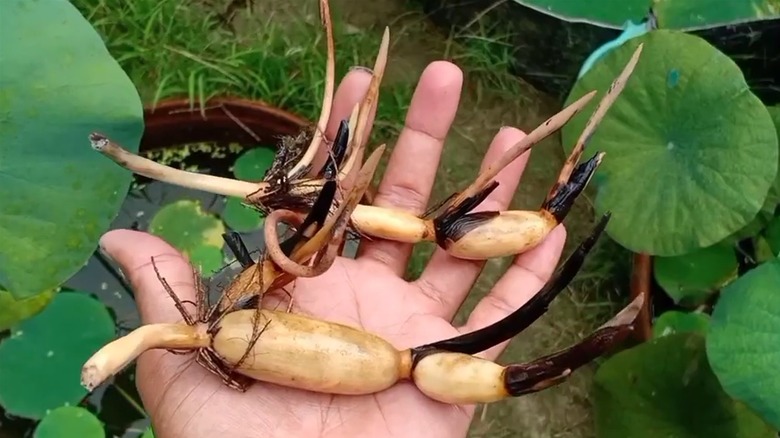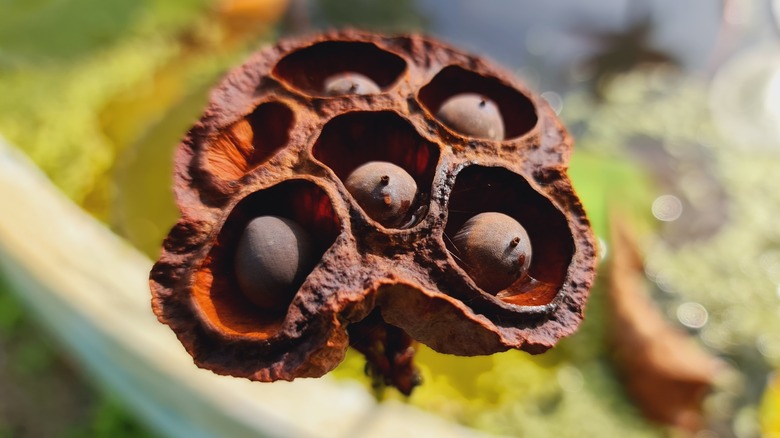How To Grow And Care For Lotus Flowers (& The Best Seeds To Shop For)
Lotus flowers are known for their rich symbolic and cultural significance. The way these striking aquatic flowers retire each night to a muddy den and return fresh, clean, and beautiful the next morning has inspired themes of resilience and rebirth for centuries. There are two types of lotus flowers: sacred lotus (Nelumbo nucifera) and American lotus (Nelumbo lutea). The former is a pink flower, the latter is yellow one. While these stunning pond flowers are often showcased in botanical gardens for public admiration, it are actually quite simple to plant and grow your own lotuses at home. Just keep in mind that adding one to your home or garden means adding an outdoor water feature as well.
To get started, you'll need a large shallow planter without drainage holes, along with tubers or seeds (tubers are highly recommended), loam or an aquatic potting soil mix, and water. If you've chosen to grow your lotus from seed, make sure to select non-hybridized versions. You'll also need a carefully timed plan to ensure that the plant has enough time to grow tubers before winter, but isn't spending enough time indoors to wither and die. If you've been admiring these gorgeous flowers from afar, now is the time to grow your own lotus blooms. As an added bonus, lotus flower seed pods have tons of uses, from decorative to culinary.
Growing and transplanting a mighty lotus
Since most of today's lotus plants are hybrid varieties, planting from seed does not typically produce a copy of the parent plant. For a more predictable result, it is recommended to grow new lotuses from tubers rather than seeds. Fill your large planter with your heavy soil of choice (a light, fluffy potting soil will float away when you add water). Dig a shallow trench in the soil's surface and lay the tuber in it.
Gently place a small stones atop the tuber and soil to prevent floating, leaving the tips exposed. Find a location that receives at least six hours of full sun daily. Fill the pot with water or submerge it into your pond until the tuber is covered by a couple of inches of water. Smaller varieties of lotus will need as little as 1 inch of water above the soil while large lotuses will require as much as 7 inches.
For those who prefer to take a chance on growing from seed, be sure to select species seeds rather than a hybrid variety for the best chance of growing a plant that resembles its parent. It is recommended to start your seeds indoors in early May in order to transplant them with enough time to develop healthy tubers before the next frost. Start by scraping away the hard brown outer shells (a process that you can try known as seed scarification). Then, simply drop the seeds into cups of water. Once each seed has produced a long shoot and a small coin leaf, they are ready to be transplanted into a pot and submerged.
Nurturing a sacred or American lotus flower
Regardless of whether they were started from tubers or seeds, when a lotus plant produces leaves that emerge from the water, it is ready for an aquatic fertilizer to be applied every three weeks during its active growing season. It is important to note that lotus plants should always remain potted and should only be placed in privately owned ponds — never in public or shared bodies of water. Both varieties of lotus flowers are very aggressive colonizers that can be extremely difficult to control one they've begun to spread. While the American lotus is a native plant in the southern United States, it is still considered invasive outside of that region. Sacred lotus is native to Asia and is considered invasive in many U.S. regions. It is even prohibited in the state of Wisconsin.
While you can technically grow a lotus flower in USDA hardiness zones 4 through 11, the plant will need to be overwintered in all but the warmest climates. Before the first frost of the fall, move your potted lotus into a cool, dark area that is shielded from frost, like a garage or shed. This will keep the plant dormant over the winter, but prevent frost damage to its leaves or tubers. But be aware that lotuses are not particularly suited for living indoors for longer than it takes to sprout and mature enough to be transplanted and move outdoors.


